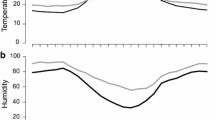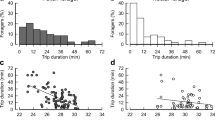Summary
1. The foraging activities of the papilionid butterflies Ornithoptera priamus poseidon and Papilio ulysses, and the solitary bee Amegilla sapiens (Apoidea, Anthophoridae) on the shrub Stachytarpheta mutabilis were studied in highland Papua New Guinea. 2. The insects' activity patterns were analysed at three sites with differing diurnal microclimate variation. O. priamus and A. sapiens foraged in the morning (after a period of basking and wing-whirring) and late afternoon when temperatures were well below daily maxima, whereas P. ulysses showed foraging peaks during the hottest part of the day. 3. Site choice by all 3 species appeared to be determined primarily by temperature, but within the limits imposed by temperature, nectar supplies probably determined which site was visited. 4. P. ulysses showed interspersed foraging and courtship behaviour, and no behavioural switching was observed for this species. At high temperatures, both O. priamus and A. sapiens ceased foraging and showed territorial and courtship behaviour. This behavioural change allowed avoidance of heat stress, and occurred even when nectar supplies were maintained at high levels. 5. Thermal effects on behavioural switching in these insects are compared with related phenomena in other bees and butterflies.
Similar content being viewed by others
References
Alcock J, Barrows EM, Gordh G, Hubbard LJ, Kirkendall L, Pyle DW, Ponder TL, Zalom FG (1978) The ecology and evolution of male reproductive behaviour in the bees and wasps. Zoological Journal of the Linnean Society 64: 293–326
Alcock J, Eickwort GC, Eickwort KR (1977) The reproductive behaviour of Anthidium maculosum (Megachilidae) and the evolutionary significance of multiple copulations by females. Behav Ecol Sociobiol 2: 385–396
Bakken GS (1976) A heat transfer analysis of animals: Unifying concepts and the application of metabolism chamber data to field ecology. J Theoret Biol 60: 337–384
Balduf WV (1962) Life of the carpenter bee Xylocopa virginica (Anthophoridae). Linn Ann Ent Soc Am 55: 263–271
Barrows EM (1983) Male territoriality in the carpenter bee Xylocopa virginica virginica (Anthophoridae). Anim Behav 31: 806–813
Bohart GE (1958) Alfalfa pollinators with special reference to species other than honey bees. Proc 10th Int Congr Ent (1956) 4: 929–937
Butler CG (1945) The influence of various physical and biological factors of the environment on honeybee activity: An examination of the relationship between activity and nectar concentration and abundance. J Exp Biol 21: 5–12
Casey TM (1981) In: Heinrich B (ed). Insect Thermoregulation, John Wiley & Sons, New York, USA
Chappell M (1982) Temperature regulation of carpenter bees (Xylocopa californica) foraging in the Colorado Desert of southern California. Physiol Zool 55: 267–280
Chappell M (1984) Temperature regulation and energetics of the solitary bee Centris pallida during foraging and inter-male mate competition. Physiol Zool 57: 215–225
Cooper PD, Schaffer WM, Buchmann SL (1985) Temperature regulation of honeybees (Apis mellifera) foraging in the Sonoran Desert. J Exp Biol 114: 1–15
Corbet SA, Willmer PG, Beament JWL, Unwin DM, Prys Jones OE (1979) Post secretory determinants of sugar concentration in nectar. Plant Cell Environm 2: 293–300
Corbet SA, Willmer PG (1981) The nectar of Justicia and Columnea: Composition and concentration in a humid tropical climate. Oecologia 51: 412–418
Coville RE, Frankie GW, Buchmann SL, Vinson SB, Williams HJ (1986) Nesting and male behaviour of Centris dirrhoda (Hymenoptera, Anthophoridae) in Costa Rica with chemical analysis of the hindleg glands of males. J Kans Ent Soc 59: 325–336
Digby PSB (1955) Factors affecting the temperature excess of insects in sunshine. J Exp Biol 32: 279–298
Elton CS (1966) The pattern of animal communities. Methuen. London
Gerling D, Hurd PD, Hefetz A (1983) Comparative behavioural biology of two Middle Eastern species of carpenter bee. Smithson Contr Zool 369: 1–33
Haugum J, Low AM (1979) A monograph of the Birdwing butterflies. Scandinavian Scientific Press. Klampenborg, Denmark
Heinrich B (1972) Thoracic temperatures of butterflies in the field near the equator. Comp Biochem Physiol 43A: 747–756
Heinrich B (1975b) The energetics of pollination. Ann Rev Ent Syst 6: 139–170
Heinrich B (1986) Comparative thermoregulation of four montane butterflies of different mass. Physiol Zool 59 (6): 616–626
Heinrich B, Buchmann SL (1986) Thermoregulatory physiology of the carpenter bee Xylocopa varipunctata. J Comp Physiol B 156: 557–562
Hurd PD, Linsley EG (1975) The principal Larraea bees of the southwestern United States. Smithson Contr Zool 193
Janzen DH (1966) Notes on the behaviour of the carpenter bee Xylocopa fimbriata in Mexico. J Kans Ent Soc 39: 633–641
Kingsolver JG (1983) Thermoregulation and flight in Colias butterflies: elevational patterns and mechanistic limitations. Ecology 64: 534–545
Kammer AE (1981) In: Heinrich B (ed) Insect Thermoregulation. John Wiley & Sons, New York
Lieftinck MA (1955) The carpenter bees of the Lesser Sunda islands and Tanimbar. Verh Naturf Ges Basel 66: 5–32
Linsley EG (1970) Some competitive relationships among matinal and late afternoon foraging activities of caupolocanine bees in southeastern Arizona. J Kans Ent Soc 43: 251–261
Louw GN, Nicolson SW (1983) Thermal, energetic and nutritional considerations in the foraging and reproduction of the carpenter bee Xylocopa capitata (Anthophoridae). J Ent Soc S Africa 46: 227–240
MacSwain JW, Raven PH, Thorp RW (1973) Comparative behaviour of bees and Onagraceae 4. Clarkia bees of the western United States. Univ Calif Publ Ent 70: 1–80
Özbek H (1976) Pollinator bees on alfalfa in the Erzurum region of Turkey. J Apic Res 15: 145–148
Raw A (1975) Territoriality and scent marking by Centris males in Jamaica (Hymenoptera; Anthophoridae). Behaviour 54: 311–321
Rawlins JE (1980) Thermoregulation by the Black Swallowtail Papilio polyxenes (Lepidoptera: Papilionidae). Ecology 61 (2): 345–357
Schaffer WM, Jensen DB, Hobbs DE, Gurevitch J, Todd JR, Schaffer MV (1979) Competition, foraging energetics and the cost of sociality in three species of bees. Ecology 60: 976–987
Schlising RA (1970) Sequence and timing of bee foraging in the flowers of Ipomoea and Aniseia (Convolvulaceae). Ecology 51: 1061–1067
Sokal RR, Rohlf FJ (1969) Biometry: The principles and practice of statistics in biological research. W.H. Freeman & Co., San Francisco
Straatman R, Schmid F (1975) Notes on the biology of Ornithoptera goliath and O. chimaera. J Lep Soc 29:85–88
Szabo TI, Smith MV (1972) The influence of light intensity and temperature on activity of the alfalfa leaf cutter bee Megachile rotundata under field conditions. J Apic Res 11:157–165
Velthuis HHW, De Camargo JM (1975a) Observations on male territories in a carpenter bee Xylocopa (Neoxylocopa) hirsutissima (Hymenoptera, Anthophoridae). Z Tierpsychol 38:409–418
Wainwright CM (1978) Hymenoptera territoriality and its influences on the pollination ecology of Lupinus arizonicus. Southwestern Nat 23:605–616
Williams HJ, Vinson SB, Frankie GW (1984) Morphology, chemical contents and possible function of the tibial glands of males of the Costa Rican solitary bee Centris trigonoides subtarsa (Anthophoridae). J Kans Ent Soc 57:50–54
Willmer PG, Corbet SA (1981) Temporal and microclimatic partitioning of the floral resources of Justicia aurea amongst a concourse of pollen vectors and nectar robbers. Oecologia 51:67–78
Willmer PG (1982) Hygrothermal determinants of insect activity patterns: the Diptera of water-lily leaves. Ecol Ent 7:221–231
Willmer PG (1983) Thermal constraints on activity patterns in nectar-feeding insects. Ecol Ent 8:455–469
Willmer PG (1985a) Size effects on the hygrothermal balance and foraging patterns of a sphecid wasp, Cerceris arenaria. Ecol Ent 10:469–479
Willmer PG (1985b) Thermal ecology, size effects and the origins of communal behaviour in Cerceris wasps. Behav Ecol Sociobiol 17:151–160
Willmer PG (1986) Foraging patterns and water balance: Problems of optimization for a xerophilic bee Chalicodoma sicula. J Anim Ecol 55:941–962
Willmer PG, Unwin D (1981) Field analysis of insect heat budgets: Reflectance, size and heating rates. Oecologia 50:250–255
Author information
Authors and Affiliations
Rights and permissions
About this article
Cite this article
Stone, G.N., Amos, J.N., Stone, T.F. et al. Thermal effects on activity patterns and behavioural switching in a concourse of foragers on Stachytarpheta mutabilis (Verbenaceae) in Papua New Guinea. Oecologia 77, 56–63 (1988). https://doi.org/10.1007/BF00380925
Received:
Issue Date:
DOI: https://doi.org/10.1007/BF00380925




